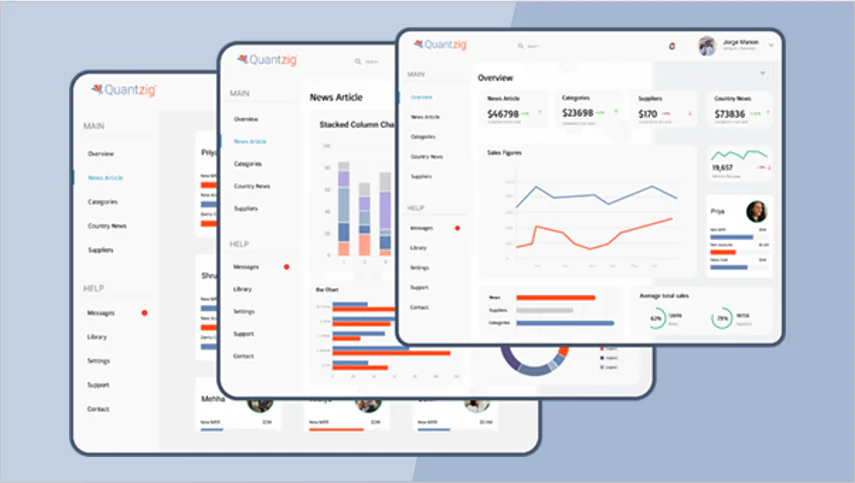In today’s fast-paced business environment, companies must evolve rapidly to stay competitive. Digital transformation has emerged as a vital catalyst that reshapes operations, enhances customer experiences, and drives organizational growth. Businesses that adapt to digital innovations can unlock new avenues for revenue, efficiency, and market relevance.
This article explores the transformative power of digital transformation and how organizations can navigate this change to improve performance. From automation and AI integration to centralized platforms and agile workflows, discover how embracing digital transformation is not just about technology—it’s about building a smarter, faster, and more customer-focused business model.
Book a demo to experience the meaningful insights we derive from data through our analytical tools and platform capabilities.
Request a Demo
Table of Contents
What is Digital Transformation?
Digital transformation refers to the strategic adoption of digital technologies to fundamentally change how organizations operate and deliver value. It involves automating manual processes, centralizing operations, integrating AI-driven tools, and fostering a data-driven culture to enable smarter decisions and improved customer experiences.
Importance
Digital transformation is crucial in enabling businesses to respond to rapidly shifting customer expectations, reduce operational inefficiencies, and gain a competitive edge. By digitizing critical processes, organizations achieve speed, precision, and scalability—core drivers of sustainable growth in a digital-first economy.
Advantages
- Streamlined Operations
Automating routine tasks reduces manual errors, speeds up workflows, and improves process reliability across departments. - Improved Customer Experience
AI-powered platforms and self-service tools respond faster to queries, enhancing satisfaction and building long-term customer loyalty. - Increased Transparency
Real-time dashboards and centralized systems provide visibility into operations, helping leaders make faster, data-driven decisions. - Enhanced Agility
Digitally enabled organizations adapt quickly to market changes, customer demands, and internal disruptions, ensuring business continuity. - Cost Efficiency
Digital transformation minimizes operational costs by reducing manual effort, optimizing resource use, and improving scalability.
Disadvantages
- High Implementation Costs
Initial investment in tools, training, and integration may be substantial, especially for large-scale transformation projects. - Resistance to Change
Employees may resist new systems due to unfamiliarity or fear of job displacement, slowing down adoption. - Technology Misalignment
Selecting tools that don’t align with long-term goals can lead to ineffective implementation and wasted investment. - Security Risks
Digital platforms introduce vulnerabilities like cyberattacks and data breaches without strong governance and compliance strategies. - Dependency on Vendors
Heavy reliance on third-party solutions can limit customization, flexibility, and control over key business processes.
Strategies
- Start with High-Impact Areas
Begin with departments that show the highest inefficiencies or customer dissatisfaction to generate quick wins and internal buy-in. - Invest in Scalable Technologies
Choose digital tools that can evolve with your business needs and accommodate future expansion or complexity. - Train and Upskill Teams
Provide hands-on training to ensure that teams understand and effectively use new systems. - Establish a Centralized Digital Platform
Use a unified platform for operations, data sharing, and stakeholder collaboration to reduce silos and boost transparency. - Monitor and Optimize Continuously
Track KPIs, gather feedback, and refine digital workflows regularly to ensure ongoing efficiency and alignment.
Applications
Digital transformation is transforming the retail sector through centralized AI platforms that resolve customer queries within seconds, significantly improving satisfaction. These innovations not only streamline service delivery but also help in customer retention and brand growth.
In the healthcare and pharma sectors, businesses are using automation to improve data collection, patient support, and regulatory compliance. Digital tools speed up clinical trials and improve communication between patients and providers.
Manufacturing companies leverage IoT and analytics to monitor production lines, predict machine failures, and reduce downtime. This level of real-time visibility ensures better quality control and cost optimization.
E-commerce firms are embracing digital transformation to enhance backend operations, enable real-time inventory management, and deliver seamless omni-channel experiences, giving them a competitive edge in an oversaturated market.
What the Future Holds?
The future of digital transformation will be shaped by advancements in AI, predictive analytics, and low-code platforms. These innovations will empower businesses to build scalable, customizable solutions faster and at a lower cost, while continuously adapting to customer demands and regulatory shifts.
With 5G adoption and real-time data integration, businesses will gain the agility to respond instantly to market trends and disruptions. This hyperconnected environment will enable personalized experiences, autonomous operations, and cross-functional collaboration—making digital transformation a key differentiator in the years ahead.



